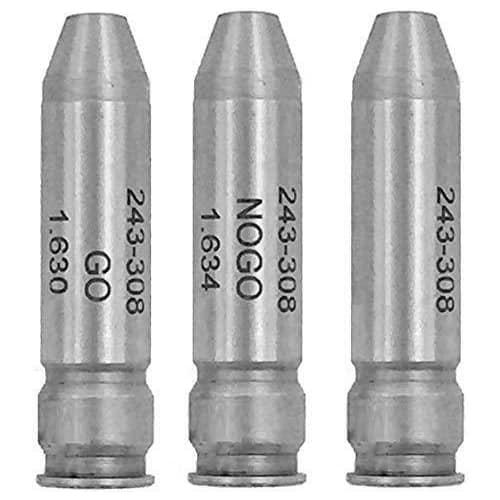
Headspace Gauge:
Headspace is measured with a set of two headspace gauges; a “Go” gauge, and a “No-Go” gauge. Headspace gauges resemble the cartridges for the chambers they are designed to headspace, and are typically made of heat-treated tool steel. Both a “Go” and a “No-Go” gauge are required for a gunsmith to headspace a firearm properly.
A third gauge, the “Field” gauge, is used (as the name implies) in the field to indicate the absolute maximum safe headspace. This gauge is used because, over time, the bolt and receiver will wear, the bolt and lugs compress, and the receiver may stretch, all causing the headspace to gradually increase from the “factory specs” measured by the “go” and “no-go” gauges. A bolt that closes on “no-go” but not on “field” is close to being unsafe to fire, and may malfunction on cartridges that are slightly out of spec.
Headspace gauges are typically used by inserting the gauge into the bolt face engaging the extractor claw and then into the firearm chamber, and noting which gauge the bolt fully closes upon, and which it does not. The closing force applied to the bolt on a bolt-action firearm when making these assessments should be consistently and lightly applied; otherwise, an incorrect assessment of headspace will result if the bolt is forced close with excessive pressure. (Source: Davis, William C., Jr. Handloading (1981) National Rifle Association)
Headspace Gauge Function:
| Gauge | Measurement | If Bolt Closes on Gauge | If Bolt Does Not Close on Gauge |
|---|---|---|---|
| Go | Minimum factory-spec spacing | “Go”. Headspace is greater than minimum spec. | “No-Go.” Headspace is too short. Bolt will not close on factory-spec cartridges, resulting in jammed brass, and firing out-of-battery, both dangerous conditions, or not firing at all. |
| No-Go | Maximum factory spec spacing | “No-Go.” Headspace is greater than the maximum factory spec. Risk of case ruptures and escaping high pressure gas if used. | “Go”. Headspace is below maximum factory spec. |
| Field | Absolute maximum safe spacing. | Rifle is unsafe to fire. Headspace is greater than what is considered safe to fire. High risk of case rupture if fired. | Generally “go”. Headspace is below the maximum for what is considered safe to fire when using factory spec ammunition. Rifle should be evaluated by a gunsmith for possible re-headspacing. |
